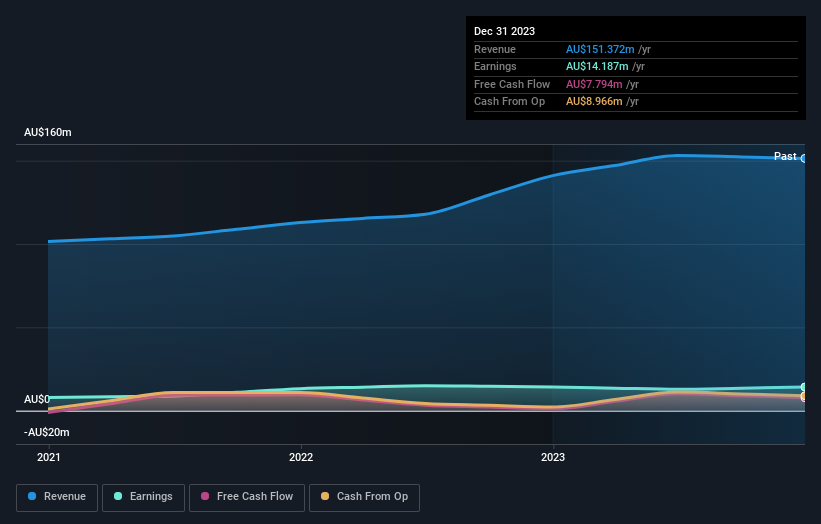Bisalloy Steel Group Limited's (ASX:BIS) market cap rose AU$20m last week; individual investors who hold 43% profited and so did insiders
Key Insights
Significant control over Bisalloy Steel Group by individual investors implies that the general public has more power to influence management and governance-related decisions
50% of the business is held by the top 12 shareholders
If you want to know who really controls Bisalloy Steel Group Limited (ASX:BIS), then you'll have to look at the makeup of its share registry. With 43% stake, individual investors possess the maximum shares in the company. In other words, the group stands to gain the most (or lose the most) from their investment into the company.
While individual investors were the group that reaped the most benefits after last week’s 15% price gain, insiders also received a 22% cut.
In the chart below, we zoom in on the different ownership groups of Bisalloy Steel Group.
View our latest analysis for Bisalloy Steel Group
What Does The Institutional Ownership Tell Us About Bisalloy Steel Group?
Many institutions measure their performance against an index that approximates the local market. So they usually pay more attention to companies that are included in major indices.
As you can see, institutional investors have a fair amount of stake in Bisalloy Steel Group. This implies the analysts working for those institutions have looked at the stock and they like it. But just like anyone else, they could be wrong. If multiple institutions change their view on a stock at the same time, you could see the share price drop fast. It's therefore worth looking at Bisalloy Steel Group's earnings history below. Of course, the future is what really matters.
We note that hedge funds don't have a meaningful investment in Bisalloy Steel Group. Peter Smaller is currently the company's largest shareholder with 16% of shares outstanding. For context, the second largest shareholder holds about 12% of the shares outstanding, followed by an ownership of 6.1% by the third-largest shareholder.
Looking at the shareholder registry, we can see that 50% of the ownership is controlled by the top 12 shareholders, meaning that no single shareholder has a majority interest in the ownership.
Researching institutional ownership is a good way to gauge and filter a stock's expected performance. The same can be achieved by studying analyst sentiments. As far as we can tell there isn't analyst coverage of the company, so it is probably flying under the radar.
Insider Ownership Of Bisalloy Steel Group
The definition of an insider can differ slightly between different countries, but members of the board of directors always count. Management ultimately answers to the board. However, it is not uncommon for managers to be executive board members, especially if they are a founder or the CEO.
Most consider insider ownership a positive because it can indicate the board is well aligned with other shareholders. However, on some occasions too much power is concentrated within this group.
Our most recent data indicates that insiders own a reasonable proportion of Bisalloy Steel Group Limited. Insiders have a AU$34m stake in this AU$156m business. This may suggest that the founders still own a lot of shares. You can click here to see if they have been buying or selling.
General Public Ownership
The general public, who are usually individual investors, hold a 43% stake in Bisalloy Steel Group. While this size of ownership may not be enough to sway a policy decision in their favour, they can still make a collective impact on company policies.
Private Company Ownership
We can see that Private Companies own 22%, of the shares on issue. It might be worth looking deeper into this. If related parties, such as insiders, have an interest in one of these private companies, that should be disclosed in the annual report. Private companies may also have a strategic interest in the company.
Next Steps:
It's always worth thinking about the different groups who own shares in a company. But to understand Bisalloy Steel Group better, we need to consider many other factors. For instance, we've identified 1 warning sign for Bisalloy Steel Group that you should be aware of.
Of course this may not be the best stock to buy. Therefore, you may wish to see our free collection of interesting prospects boasting favorable financials.
NB: Figures in this article are calculated using data from the last twelve months, which refer to the 12-month period ending on the last date of the month the financial statement is dated. This may not be consistent with full year annual report figures.
Have feedback on this article? Concerned about the content? Get in touch with us directly. Alternatively, email editorial-team (at) simplywallst.com.
This article by Simply Wall St is general in nature. We provide commentary based on historical data and analyst forecasts only using an unbiased methodology and our articles are not intended to be financial advice. It does not constitute a recommendation to buy or sell any stock, and does not take account of your objectives, or your financial situation. We aim to bring you long-term focused analysis driven by fundamental data. Note that our analysis may not factor in the latest price-sensitive company announcements or qualitative material. Simply Wall St has no position in any stocks mentioned.

 Yahoo Finance
Yahoo Finance 

